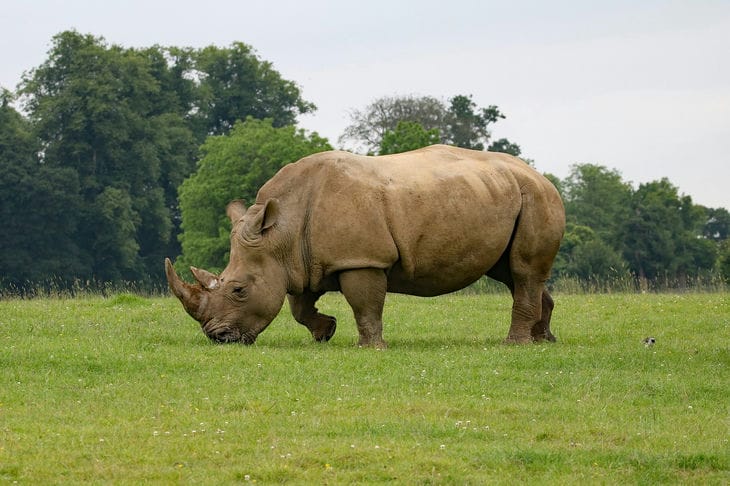On our planet you can find a huge variety of all kinds of animals.
They can be quite harmless, but there are also those that pose a huge danger.
Next we will talk about those who pose a real threat to humans.

Yellow Scorpion
The venom of the yellow scorpion consists of a mixture of neurotoxins. These are toxic substances that affect the nerve cells of the victim.
At the site of the scorpion bite, redness and swelling, severe, burning pain, cramps, shortness of breath, and a pre-fainting state immediately appear.
If medical assistance is not provided in time, a fatal outcome may occur. For elderly people and children, such a bite is very likely to be fatal.
Rhinoceros
One of the largest representatives of the animal world on the planet. Living in Africa and Asia.
As a rule, they are not aggressive, avoid humans, and are exclusively herbivorous. However, an enraged rhinoceros is extremely dangerous.
Accelerating to 56 km/h, weighing about 4.4 tons, it rushes at the enemy like a locomotive, striking with a powerful, sharp horn. With such strength and enormous mass, it can cause serious injury to a person.
Stonefish or wartfish
This fish is the leader among poisonous fish. It can grow up to 50 cm in length, has a large head, small eyes and a large mouth. The body is covered with tubercles and protrusions on the back, which contain poison. It looks like a stone, for which it received its nickname.
Lives in the coral reef zone of the Pacific and Indian Oceans. Stonefish venom consists of a mixture of several proteins and neurotoxins that affect nerve tissue. Causes very severe pain throughout the body, rapid loss of consciousness.
Without immediate medical care, death occurs. Even if a person receives medical care, he will remain ill for several months.
Shark
They also cannot be ignored. The most ancient predators that lived on earth.
Having appeared about 420 ml years ago, they still remain one of the most dangerous representatives of predatory fish. They live in all seas, are found off the coast of Antarctica, the Pacific Ocean, and the Atlantic.
To track down prey, sharks have an extremely keen sense of smell, allowing them to detect minute concentrations of blood in the water at a distance of 5 km.
Excellent natural camouflage for approaching prey, strength, speed and several rows of razor-sharp teeth leave virtually no chance for potential prey.
It poses a huge danger to humans.
Black Mamba
The black mamba is one of the most dangerous snakes on the planet. It lives in tropical regions of Africa, and is found in Congo, Somalia, Sudan, Uganda, and southern Ethiopia. It grows to about 3 meters in length, weighs an average of 1.6 kg, and is colored from deep olive to black. It can reach speeds of up to 20 km/h over short distances.
The diet consists of small rodents and birds. The snake is extremely dangerous to humans. It usually does not attack people, but when threatened, it inflates its hood, lifts its body and opens its pitch-black mouth, which is how it got its name.
The bite site is enveloped in a burning pain, the lesion swells, tissues die, abdominal pain, nausea, vomiting, diarrhea. For a bite, the reptile injects into the victim from 100 to 400 mg of a mixture of neuro, cardio and dentro toxins (10 mg without an antidote cause a lethal outcome). Mamba venom can kill even an elephant, without medical assistance a person will die within 30 minutes.
African buffalo
The African buffalo is a formidable, strong, powerful animal. Height up to 1.9 meters, length 2.5 - 3.0 meters, weight reaches 1 ton.
The African buffalo is dark gray or black in color. A herbivore, it prefers to gather in huge herds of up to 1,000 individuals, and lives in Africa, choosing places rich in water sources and dense vegetation. The animal is constantly wary and extremely aggressive.
They attack or defend themselves in groups of several individuals. Thanks to their massive, sharp horns and large mass, they can easily knock an enemy to the ground, finishing them off with their hooves. They are extremely dangerous to humans.
Poison dart frogs
Amazing bright, beautiful, tropical frogs are the most poisonous on the planet. Habitats are savannas, humid forests of South and Central America.
They prefer to settle in trees, spending most of their lives there. Thanks to the membranes and suckers on their paws, they easily move along branches and leaves, for which they received their nickname. The length of an adult frog is about 12 cm.
The color is bright, warning of danger, it can be blue, green, yellow, red, etc. They feed on various midges, termites, bugs and other insects.
Frog poison consists of more than a hundred different substances and is extremely toxic.
The poison is on the skin of the poison dart frog, even a small amount of it on human skin can cause death. It leads to paralysis of the upper respiratory tract, arrhythmia, and ventricular fibrillation.
Polar bear
The largest land-dwelling mammal predator on our planet. It lives exclusively in the polar regions of the north, the shores of the Kara and East Siberian, Laptev, Barents seas.
The body length is up to 3 meters, height from 1-5 meters, weight is about 800 kg. The bear's body, with the exception of the nose and paw pads, is covered with thick, white fur, protecting it from severe frosts.
The polar bear has virtually no natural enemies, and hunts mainly ringed seals and harpoons. Thanks to its large, sharp teeth and massive claws, it does this very well.
There are known precedents of bears attacking humans, although in most cases, the fault lies with the person who invaded the territory of the hungry beast.
Lions
One of the largest members of the cat family, these large cats have yellowish-brown fur, long tails, and a black tuft at the end.
Males have a luxurious mane. Lives in the southern part of the African continent and in the Indian state of Gujarat, prefers savannas, forests and bushes. Body length from 1.7 to 2.5 meters, weight up to 250 kg, height about 1.2 meters.
It has everything it needs for a successful hunt: 30 sharp teeth and 8 cm fangs that cut through flesh, claws on its paws that reach 7 cm. It feeds on large animals such as deer, wild boars, antelopes, zebras, buffalos, and giraffes. It can also attack a person, which will most likely lead to tragic consequences.
Fugu
The fugu fish, or dogfish, also known as the yellow pufferfish, lives in subtropical waters off the coast of Japan, the Indian Ocean, and the Pacific Ocean.
A few milligrams of its poison, tetrodotoxin, are enough to kill a person. One such fish can kill up to 40 people. The poison is contained in its skin and internal organs. There is no antidote against tetrodotoxin, once it enters the body, the chances of survival are extremely small.
Hyena
A family of predatory mammals of the order Cat-like. The hyena lives in Africa and Eurasia. It has a color from yellowish-brown with black spots to brown. Height up to 0.8 meters, length about 1.3 meters.
They prefer to live in large packs, where the female is the leader. The main enemies of hyenas are lions, with whom they live side by side, share food territory and compete.
They also hunt in packs, preferring to attack a single victim that has fallen behind its pack. Large teeth with powerful jaws, as well as numerical superiority, make hyenas successful hunters and extremely dangerous opponents.
Komodo dragon
Komodo dragons, at first glance, do not seem as dangerous as, for example, crocodiles. But this is not so. They live on the islands of Indonesia.
The largest and most dangerous lizard on the planet. Its weight reaches 150 kg, the body length is about 2 meters, and it can reach speeds of up to 40 km/h. The Komodo dragon is an exclusively carnivorous animal, feeding on carrion or hunting.
The monitor lizard has virtually no natural enemies. Its prey consists of deer and buffalo, as well as its smaller relatives.
In its mouth there are teeth, compressed from the sides and bent inwards, which allows it to inflict terrible wounds on its victim. The monitor lizard also has poisonous glands that produce toxic proteins.
When it enters the victim's body, it prevents blood clotting, causing hypothermia and paralysis. It is dangerous for humans, if bitten, you should immediately consult a doctor.
Viper
A poisonous representative of the snake genus, the common viper. It reaches 1 meter in length and is light gray or black in color.
Hunts during the daytime mainly for rodents. Not aggressive, in most cases tries to avoid meeting a person, crawl away. But if you accidentally step on it, a bite will immediately follow.
Viper venom contains a neurotoxin that has a negative effect on the cardiovascular system. Without medical assistance, there is a high chance of death.
Crocodile
Crocodiles are large reptiles, one of the strongest predators in the world. Crocodiles hunt with powerful jaws, with razor-sharp teeth, dragging their prey into the water. Every year, over a thousand people die from crocodiles.
African elephant
African elephants are the largest land animals, growing up to 7 meters tall and weighing around 12 tons.
Mainly lives in the territories of: Kenya, Congo, Namibia, Zimbabwe, etc. They feed exclusively on plant food. Consumes up to 3 tons of food per day. They prefer to live in groups. An elephant can easily injure a person by simply trampling him into the ground.
Malaria mosquito
It would seem that what danger could a small insect pose that feeds on the blood of animals and people?
After all, there is nothing easier than to swat this annoying creature with your hand. However, the malaria mosquito is a carrier of an extremely dangerous disease - Malaria.
A transmissible protozoan infection that enters the human body through saliva secreted by a mosquito when it bites.
In humans, it progresses rapidly; if qualified medical care is not provided in time, a fatal outcome is likely.








